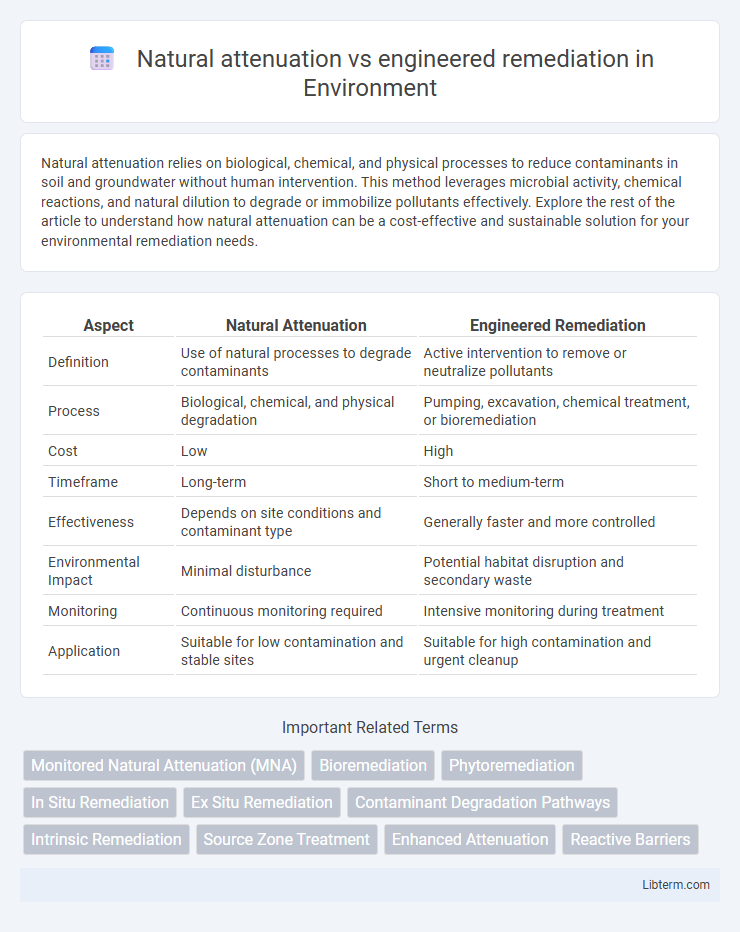Natural attenuation relies on biological, chemical, and physical processes to reduce contaminants in soil and groundwater without human intervention. This method leverages microbial activity, chemical reactions, and natural dilution to degrade or immobilize pollutants effectively. Explore the rest of the article to understand how natural attenuation can be a cost-effective and sustainable solution for your environmental remediation needs.
Table of Comparison
| Aspect | Natural Attenuation | Engineered Remediation |
|---|---|---|
| Definition | Use of natural processes to degrade contaminants | Active intervention to remove or neutralize pollutants |
| Process | Biological, chemical, and physical degradation | Pumping, excavation, chemical treatment, or bioremediation |
| Cost | Low | High |
| Timeframe | Long-term | Short to medium-term |
| Effectiveness | Depends on site conditions and contaminant type | Generally faster and more controlled |
| Environmental Impact | Minimal disturbance | Potential habitat disruption and secondary waste |
| Monitoring | Continuous monitoring required | Intensive monitoring during treatment |
| Application | Suitable for low contamination and stable sites | Suitable for high contamination and urgent cleanup |
Introduction to Environmental Remediation
Natural attenuation relies on natural processes such as biodegradation, dispersion, and chemical reactions to reduce contaminant concentrations in soil, groundwater, or surface water without human intervention. Engineered remediation involves active methods like pump-and-treat, soil excavation, or chemical oxidation to accelerate contaminant removal or stabilization in contaminated environments. Understanding the distinctions and applications of these approaches is critical to designing effective environmental remediation strategies that balance cost, time, and ecological impact.
Defining Natural Attenuation
Natural attenuation refers to the naturally occurring processes that reduce the concentration, toxicity, or mobility of pollutants in soil, groundwater, or surface water without human intervention. These processes include biodegradation, chemical transformation, dilution, sorption, and volatilization, which collectively mitigate contamination over time. Engineered remediation, by contrast, involves active human-driven methods like soil excavation, pump-and-treat systems, or chemical injections designed to accelerate contaminant removal or containment.
Understanding Engineered Remediation
Engineered remediation involves the deliberate application of technologies such as soil vapor extraction, bioremediation, or pump-and-treat systems to actively remove or neutralize contaminants from soil and groundwater. This approach is designed to accelerate contaminant degradation and prevent further spread, often used when natural attenuation processes are insufficient or too slow. Detailed site assessments and monitoring strategies ensure the effectiveness and safety of engineered remediation techniques, optimizing cleanup efforts in complex contaminated environments.
Key Differences Between Natural Attenuation and Engineered Remediation
Natural attenuation relies on natural processes such as microbial degradation, dilution, and chemical transformation to reduce contaminants in soil or groundwater, while engineered remediation employs active technologies like soil excavation, pump-and-treat systems, or chemical injections to accelerate pollutant removal. Natural attenuation is generally cost-effective and less disruptive but requires longer time frames and thorough monitoring to ensure contaminant levels decline safely. Engineered remediation provides faster contaminant reduction, greater control over site conditions, and is preferred for immediate risk mitigation or when natural processes are insufficient.
Mechanisms Driving Natural Attenuation Processes
Natural attenuation processes are driven primarily by biotic and abiotic mechanisms such as biodegradation, dispersion, dilution, sorption, and chemical transformations, which naturally reduce contaminant concentrations in soil and groundwater over time. Microbial metabolism plays a crucial role by converting harmful pollutants into less toxic compounds through enzymatic reactions under aerobic or anaerobic conditions. These intrinsic mechanisms contrast with engineered remediation, which involves active intervention techniques like pump-and-treat, soil vapor extraction, or chemical oxidation to accelerate contaminant removal.
Types of Engineered Remediation Technologies
Engineered remediation technologies include physical, chemical, and biological methods designed to actively remove or neutralize contaminants from soil, groundwater, or air. Common types encompass pump-and-treat systems, soil vapor extraction, bioremediation, chemical oxidation, and thermal desorption, each selected based on site-specific conditions and contaminant characteristics. These technologies offer targeted, accelerated clean-up compared to natural attenuation, which relies on inherent microbial and geochemical processes over extended periods.
Factors Influencing Remediation Strategy Selection
Remediation strategy selection depends on site-specific factors such as contaminant type, concentration, and hydrogeological conditions. Natural attenuation is favored when contaminants degrade at acceptable rates without posing immediate risks, requiring thorough monitoring of microbial activity, geochemical parameters, and contaminant plumes. Engineered remediation becomes necessary for persistent contaminants, high toxicity, or complex matrices, with considerations including treatment efficacy, cost, time frame, and regulatory compliance.
Case Studies: Successes and Limitations
Case studies reveal that natural attenuation effectively restores groundwater quality at sites with low contaminant concentrations, such as petroleum hydrocarbons in sandy aquifers, by leveraging microbial biodegradation and geochemical processes. Engineered remediation demonstrates success in heavily contaminated industrial sites, using approaches like pump-and-treat or in situ chemical oxidation to rapidly reduce toxic constituents, though costs and long-term sustainability pose challenges. Limitations of natural attenuation include slow contaminant reduction and monitoring complexity, whereas engineered methods often encounter issues with incomplete contaminant removal and potential secondary impacts to the environment.
Environmental and Economic Considerations
Natural attenuation leverages natural processes such as biodegradation, dispersion, and chemical transformations to reduce contaminant concentrations, offering low environmental disturbance and cost-effective long-term solutions. Engineered remediation involves active interventions like soil excavation, chemical treatments, or pump-and-treat systems, which provide faster contaminant removal but often result in higher energy consumption, increased greenhouse gas emissions, and substantial operational expenses. Environmental impact assessments and cost-benefit analyses are crucial for selecting between these approaches, balancing site-specific contaminant levels, remediation goals, and budget constraints.
Future Trends in Remediation Approaches
Future trends in remediation approaches emphasize combining natural attenuation with engineered remediation techniques to enhance contaminant degradation efficiency. Advances in bioremediation and real-time monitoring technologies enable precise control and optimization of natural attenuation processes alongside engineered interventions. Integrating data-driven models with innovative materials such as nanomaterials and bioaugmentation agents is driving the evolution toward more sustainable, cost-effective remediation solutions.
Natural attenuation Infographic

 libterm.com
libterm.com